Monophyllaea
Full name and orig. publication: Monophyllaea R.Br., Cyrtandreae 121 (Dec. 1839), reimp. in Benn. & R.Br.,
Pl. jav. rar. 121 (1840).
Etymology: From the Greek μονος,
monos = single, and φυλλον, phyllon = leaf, referring to the single leaf of the plant (an enlarged cotyledon).
Synonyms: Horsfieldia
Chifflot (1909), non Willd. (1805), Moultonia J.B.Balf. & W.W.Sm. (1915).
Infrafamilial position: Epithematoid Gesneriaceae.
Description: Perennial or
annual monocarpic herbs. Stem (hypocotyl) fleshy, with medullary vascular
bundles, usually bearing a large single leaf (macrocotyledon), occasionally
caulescent with 3-4 leaves; whole plant provided with chalk glands. Leaf oblong
or suborbicular, with basal meristem, lateral nerves close together near leaf
base, becoming more widely spaced higher up. Cymes usually long-pedunculate,
arising at or just below the base of the leaf, occasionally also scattered along
the midrib, with small bracts at base flowering axis helicoid sometimes with a
basal dichasial branching, ebracteate flowers in pairs, pedicellate. In M.
singularis (W.W.Sm.) B.L.Burtt flowers borne on a very short peduncle in
crowded zone on one side of stem and/or along midrib of leaf. Sepals 5, rarely
4, descending-imbricate, the uppermost outside, somewhat broader than the rest
and often slightly carinate, streaked with longitudinal secretory canals and
with a central patch of chalk glands on the inside. Corolla in the range 5-15 mm
long, tube and limb roughly equal; tube usually bearded inside; Stamens 4, the
anterior ones strongly arcuate or curved back to bring anthers into contact,
filaments often with a small tooth at apex; anthers with divergent thecae,
confluent, usually all four cohering by their edges to form a down-facing plate,
more rarely didynamous or all free. Nectary cupular, thick, undulate or lobulate.
Ovary bilocular, with axile placentae; style simple; stigma capitate, slightly
peltate or umbilical. Fruit capsular, often thin-walled, sometimes breaking up
into 4 valves after fall of persistent, often swollen, style, or sometimes
without valves, the top of the ovary covered by the expanded style base and the
fruit effectively porose when it falls.
Chromosome number: 2n =
20, 22, 24.
Species number:
Over 30.
Species names (incl. publication and synonyms): See Skog, L.E. &
J.K. Boggan. 2005: World checklist of Gesneriaceae: http://persoon.si.edu/Gesneriaceae/Checklist.
Type species: Monophyllaea
horsfieldii R.Br.
Distribution:
Malesia (from Sumatra to New Guinea and from S Thailand and Luzon to Java).
Ecology: Growing predominantly on limestone rocks, in shady
forests, at cave entrances and below rocks.
Notes:
The closest relative is the Chinese genus Whytockia, which represents a
kind of morphological archetype of Monophyllaea (Weber 1976, Mayer et al.
2003). Monophyllaea can be divided into two
subgenera (Burtt 1978):
(1) subg. Monophyllaea:
Pedicels longer than the calyx. Placentae with a broad attachment to the septum,
presence of a single massive strand in the centre. Indumentum (if present) of
uniseriate glandular or eglandular hairs. Ca. 20 spp., throughout Malesia.
(2)
subg. Moultonia (Balf.f. & W.W.Sm.) B.L.Burtt: Pedicels equalling or
shorter than the calyx. Placentae joined to the septum by a narrow bridge, each
placenta with a main central strand. Indumentum (if present) of uniseriate
glandular or eglandular hairs, or in certain species of forked, dendroid or
stellate hairs (ca. 12 spp., Borneo, a few spp. in Ceram, the Moluccas and New
Guinea).
With regard to its unifoliate habit (the macrocotyledon reaching a
length to 1m in some species) and inflorescence architecture Monophyllaea
is one of the most peculiar genera of Gesneriaceae. Of particular interest is M. singularis (Borneo), with
the flowers emerging from the "hypocotyl" and the midrib of the single leaf
(Weber 1987, 1990, Imaichi & al. 2001). In
three species (M. caulescens B.L.Burtt, M. ramosa B.L.Burtt and M.
elongata B.L.Burtt) several leaves are produced which copy the macrocotyledon
in size and shape (phyllomorphic architecture).
A curious (probable) hybrid between Monophyllaea glabra
and Rhychoglossum obliquum was recently described by Burtt (2001).
Selected references: Weber,
Bot. Jahrb. Syst. 95: 174-207 (1975), veg. & infl. morph.; Weber, Bot. Jahrb.
Syst. 95: 435-454 (1975), fl. morph.; B.L. Burtt, Notes Roy. Bot. Gard.
Edinburgh 37: 20 (1978), rev.; Weber, Beitr. Biol. Pflanzen 52: 183-205 (1976),
morph., Whytockia; Weber, Beitr. Biol. Pflanzen 70: 405-406 (1998,
"1997"), new taxa; Kiehn & Weber, Beitr. Biol.
Pflanzen 70: 445-470 (1998, "1997"), karyol.; Imaichi et al., Pl.
Syst. Evol. 229: 171-185 (2001); Burtt, Thai Forest Bull. (Botany) 29: 81-109
(2001), annot. checklist (Thailand); morph.; Mayer, Möller, Perret,
Weber,
Amer. J. Bot. 90(2): 321-329 (2003), molec. syst.
Bibliography: See Skog, L.E. & J.K. Boggan.
2005. Bibliography of the Gesneriaceae. 2nd edition: http://persoon.si.edu/Gesneriaceae/Bibliography.
Illustrations:
Monophyllaea
subg. Monophyllaea
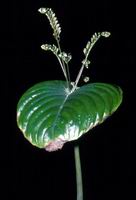
|
Monophyllaea horsfieldii R.Br., type of genus and subgenus Monophyllaea
Cult. BG Vienna, phot. A. Weber
|
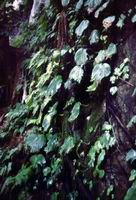
|
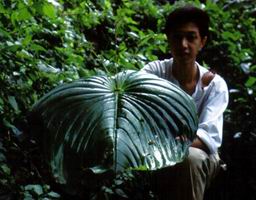
|
Monophyllaea horsfieldii R.Br.
Penins. Malaysia, Selangor, Bkt. Takun, phot. A.Weber (1979)
|
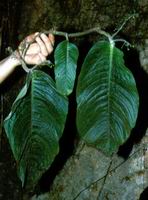
|
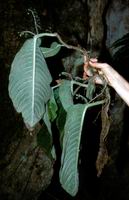
|
Monophyllaea elongata B.L.Burtt,
Penins. Malaysia, Perak, Sungai Siput Selatan, phot. A.Weber (1986)
|
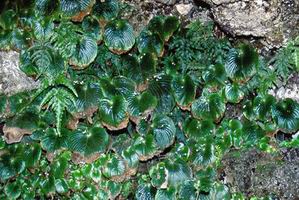
|
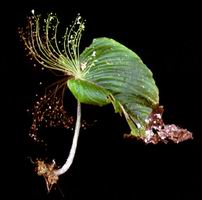
|
Monophyllaea hirticalyx Franch.
Left: Penins. Malaysia, Kelantan, Gunung Reng,
phot. A. Weber (1984)
Right: Penins. Malaysia, Penang, Kelantan, Gua Musang, phot. A. Weber (1987)
|
Monophyllaea subg. Moultonia
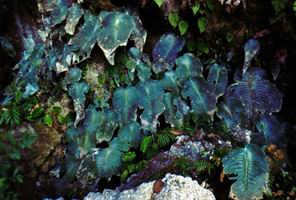
|
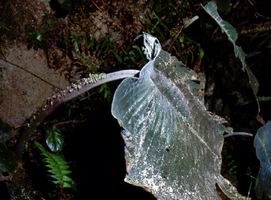
|
Monophyllaea singularis (Balf. & W.W.Sm.) B.L.Burtt, type of
subgenus Moultonia
Borneo, Sarawak, Bidi Hills, phot. A.Weber (1979)
|
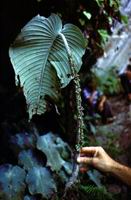
|
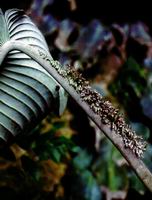
|
Monophyllaea singularis (Balf. & W.W.Sm.) B.L.Burtt
Borneo, Sarawak, Bidi Hills, phot. A.Weber (1979)
|
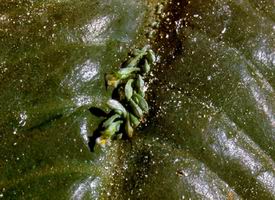
|
Monophyllaea singularis (Balf. & W.W.Sm.) B.L.Burtt
Borneo, Sarawak, Bidi Hills, phot. A.Weber (1979)
|
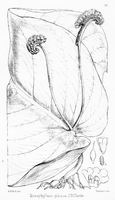
|
Monophyllaea glauca C.B.Clarke
C.B.Clarke in A. & C.DC, Monogr. phan.
5/1, t. 20 (1883)
|
last modified: 2007-01-05












